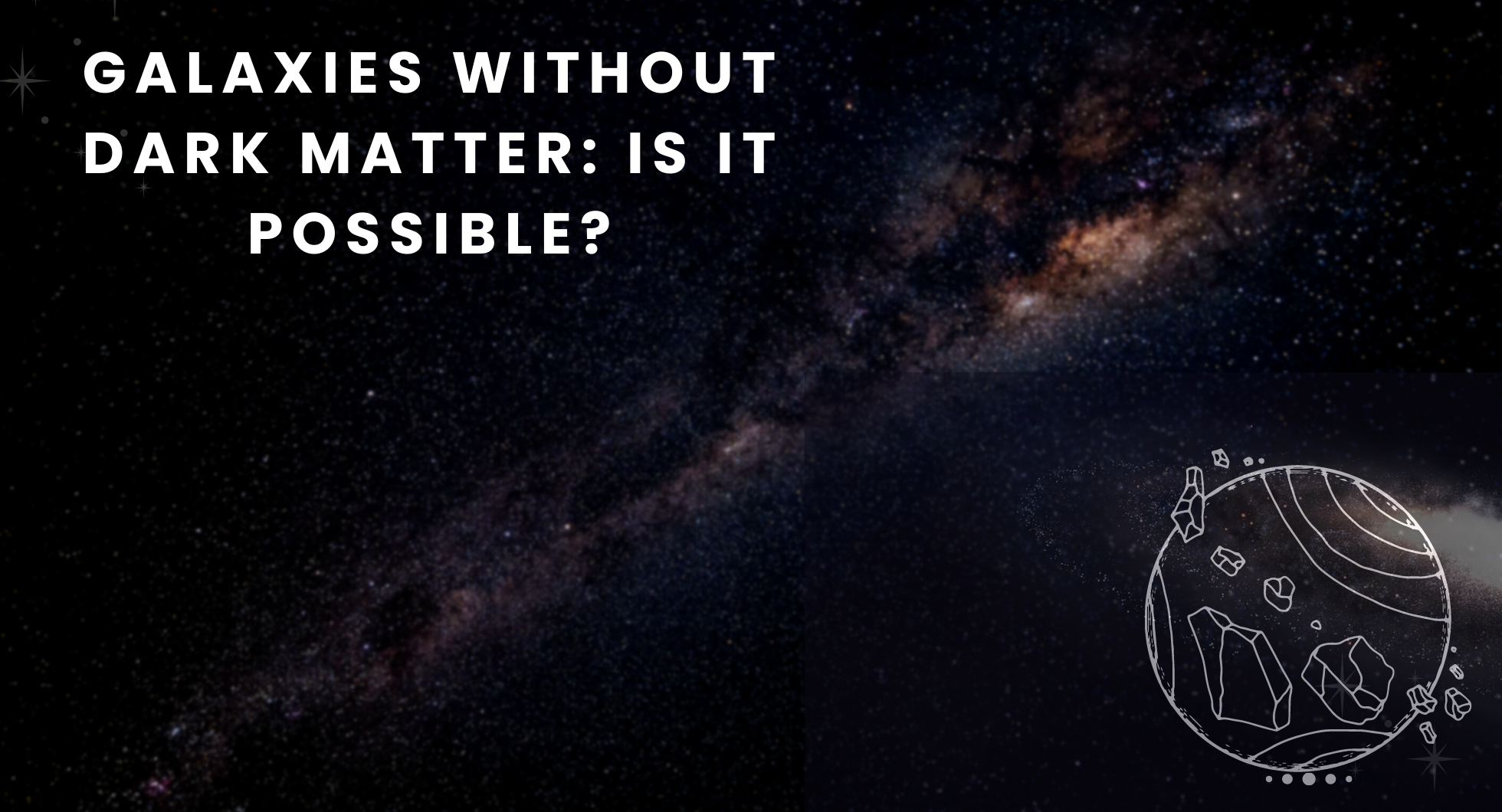Galaxies without dark matter: Is it possible?

Researchers reported in the Nature on 19th of May that two mysterious galaxies, NGC 1052-DF2 and NGC 1052-DF4, are devoid of dark matter and they could have a smashing origin story. Pieter van Dokkum and colleagues have purposed that two dwarf galaxies slammed into one another about 8 billion years ago. That cosmic crash caused the gas within those two galaxies to split up and form multiple new dwarf galaxies, including the two dark matter–free ones.
A newfound row of dwarf galaxies is supposed to be more than 6 million light-years long. The researchers say it could have formed in the aftermath of the hypothesized crash. If it’s correct, the finding could help solve the mystery of how such unusual dark matter–free galaxies form, and reveal new details about the nature of dark matter.
What is a galactic smashup?
Galactic smashup—also known as galactic cannibalism—explains the formation of dwarf galaxies. Researchers have found that a typical galaxy has hundreds of smaller satellites than larger ones, and those satellites would presumably have formed in the same way.
However, some dwarf galaxies seem to lack any satellite companions at all, which has led astronomers to consider whether they are orphans—the victims of an earlier collision with a large galaxy that stripped them bare.
What does “galaxies without dark matter” mean?
Galaxies are made up of gas and stars, but their most luminous matter is assumed to be invisible—dark matter. A major goal of astronomers is to understand why galaxies come in two very different sizes: the star clusters that make up large galaxies and the tiny dwarf galaxies that orbit larger ones.
“Large galaxies, in general, are made up of a majority of dark matter, while small galaxies are primarily composed of stars and gas,” van Dokkum says. “The question is why these two types of galaxy exist”, van Dokkum added.
Is it possible to exist in any galaxy without dark matter?
The existence of a galaxy without dark matter has been debated for decades. This is the first time that a galaxy without dark matter has been found. Other galaxies without dark matter were found in the past, but they were more like weirdos rather than a representative of regular galaxies.
Dark matter is the factor that helps a galaxy hold itself together, but that is not the case with the double lobed galaxy. In addition, the dwarf galaxy’s shape could be the result of a lopsided collision. The specimen is not round and smooth but has sharp angles and roughness, which could suggest that the object collided with itself after just one of its two lobes was severed.
Is there enough evidence to support the backstory?
Some scientists are skeptical that there’s enough evidence to support this backstory. Astronomer Michelle Collins of the University of Surrey in Guildford, England said, “If this is true, I think it would be really exciting. I just don’t think the bar has been met”.
It was in 2018 that Yale University astronomer van Dokkum and colleagues reported a dwarf galaxy with no dark matter. The invisible, mysterious substance is typically detectable in galaxies via its gravitational effects on stars.
Later, when a second dark matter–free dwarf galaxy was found in the vicinity in 2019, it raised a question about how the two oddball galaxies formed. Scientists generally think dark matter to form the foundation of all galaxies, gravitationally attracting the gas that eventually forms stars. It’s the reason that some processes must have separated the dark matter from the galaxies’ gas.
Scientists have previously seen dark matter and normal matter separate on a very large scale in the Bullet Cluster, which formed when two clusters of galaxies rammed into one another On the other hand, several researchers had proposed that something similar might happen with colliding dwarf galaxies, what van Dokkum and colleagues call “bullet dwarfs.”
Astronomers say the dwarf galaxies’ ethereal dark matter would continue on unperturbed in such a collision. It’s because dark matter doesn’t interact with other matter. But the gas from the two galaxies would slam together, eventually forming multiple clumps that would each become its own galaxy, free of dark matter.
Now, the team of van Dokkum says that the bullet dwarf idea explains the two previously reported dark matter–free galaxies — and several other galaxies nearby. They claim that the two galaxies are moving away from each other as if they had come from the same spot. What’s more, the two galaxies are part of a chain of 11 galaxies aligned in a row, a structure that could have formed in the aftermath of a bullet dwarf collision.
According to them, the two galaxies, NGC 1052-DF2 and NGC 1052-DF4, are found to be free of dark matter, are part of a line of 11 galaxies total. That linear arrangement of galaxies could have been produced by an ancient collision of two progenitor galaxies.
“It’s super satisfying to finally have an explanation for these weird objects,” said van Dokkum.
“There could be much more done to make it convincing”, Collins said. Giving an example, she said that the scientists didn’t measure the distances of all the galaxies from Earth. That means some of the galaxies could be much farther away than others, and it could be a coincidence that the galaxies appear to be lined up from our viewpoint.
Also, the researchers haven’t yet measured the velocities of all the galaxies in the trail or determined whether those galaxies are also missing their dark matter, which would help confirm whether the scenario is correct.
Some scientists including astrophysicist Eun-jin Shin of Seoul National University in South Korea, are more optimistic. Shin said, “The origin story is very plausible in my opinion”. Shin had co-written a perspective article on the discovery with astrophysicist Ji-hoon Kim, also of Seoul National University, that was also published in Nature.
The future implication of the finding
Computer simulations performed by Shin, Kim, and others have shown that bullet dwarfs can produce such dark matter–free galaxies. If confirmed, the bullet dwarf idea could help pin down dark matter’s properties, in particular, whether dark matter interacts with itself.
In the future, the bullet dwarf idea could also help astronomers understand how dwarf galaxies could arise in the first place.
Van Dokkum and colleagues are planning additional measurements that could confirm or refute the case. However, but for, he said, “It has, to me, the ring of truth.”
Concluding paragraph
So, there exist multiple galaxies which are completely devoid of dark matter; which means that there is no elemental gravity. But this kind of event, being extremely rare, is not an issue at all. Scientists are still researching on dark matter and its properties, which are very far from being understood. So yes, the discovery of such galaxies is an uncontrolled surprise. But over the entire galaxies of the universe, there can’t be any galaxies without dark matter alone.
If there are no invisible particles or mysterious forces acting in our universe, where does it come from? These elements can never exist outside a physical explanation. And even if it does occur in your account or someone else’s account besides nature, the existence of this conundrum will not go unnoticed anymore.
References:
P. van Dokkum et al. A trail of dark-matter-free galaxies from a bullet-dwarf collision. Nature. Vol. 605, May 19, 2022, p. 435. doi: 10.1038/s41586-022-04665-6.
E.-j. Shin & J.-h. Kim. Collision created galaxies devoid of dark matter. Nature. Vol. 605, May 19, 2022, p. 427. doi: 10.1038/d41586-022-01298-7.
Auto Amazon Links: No products found.


